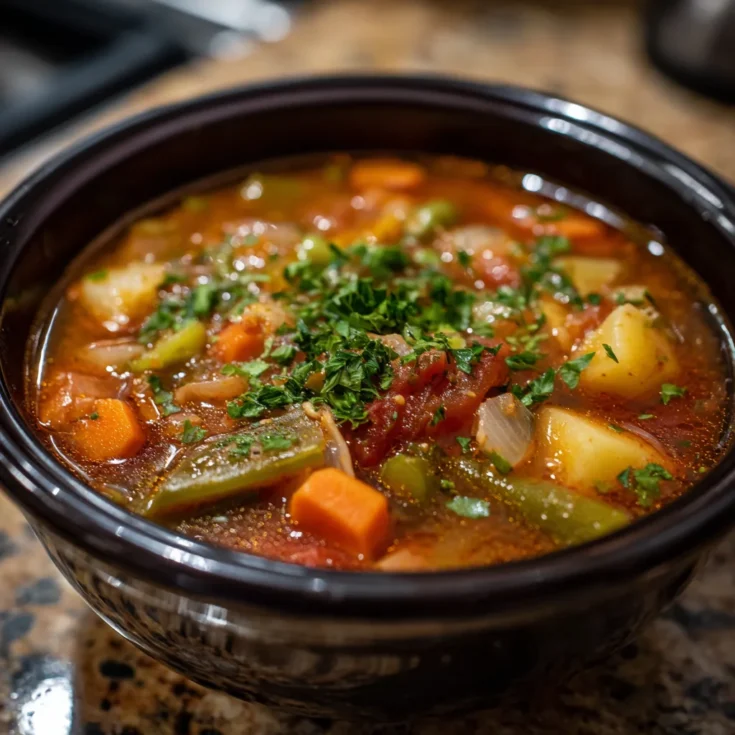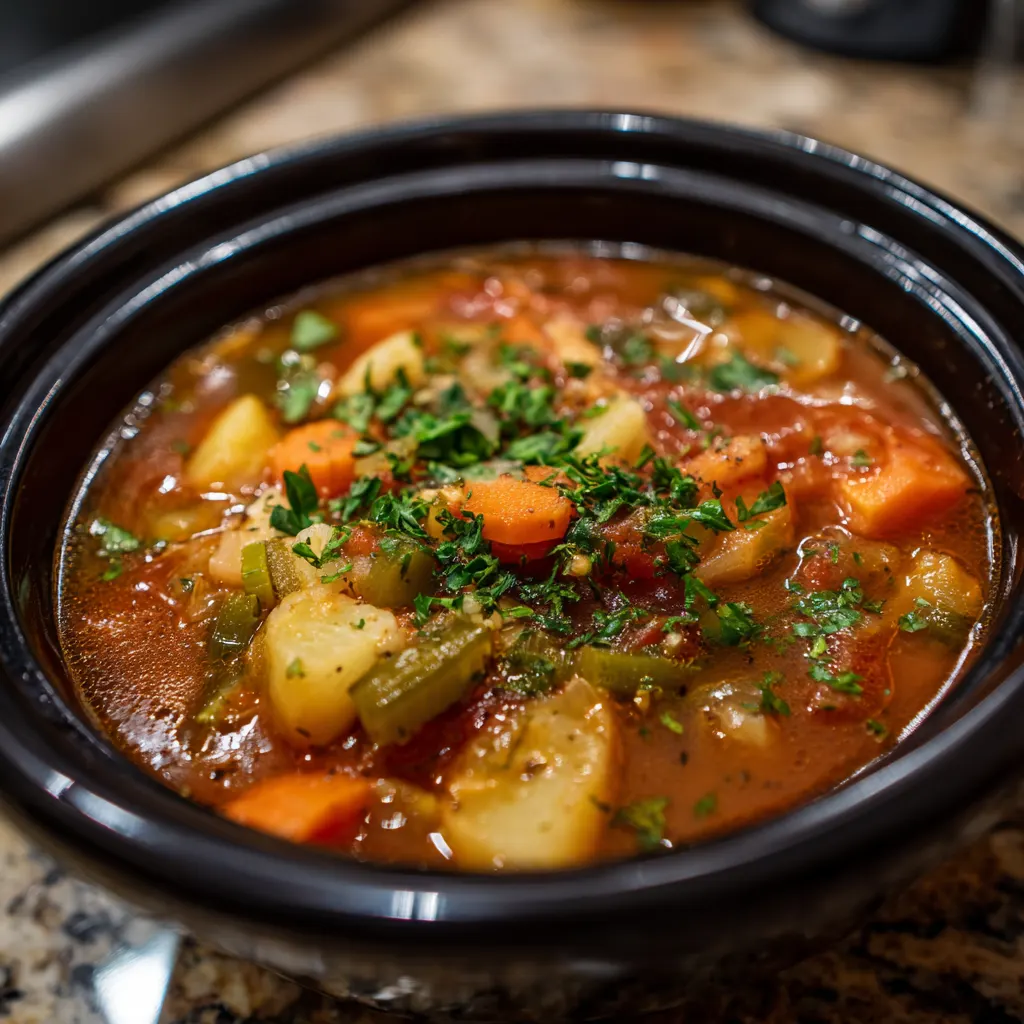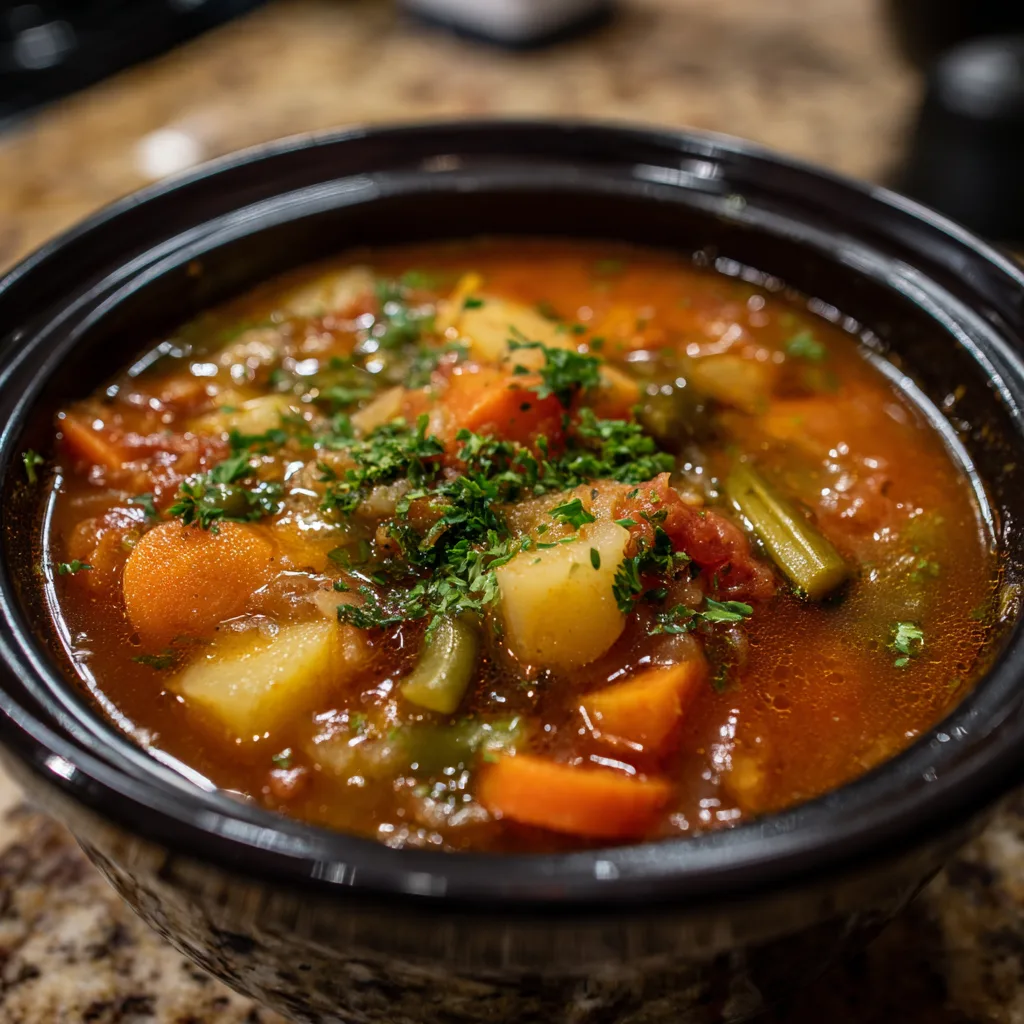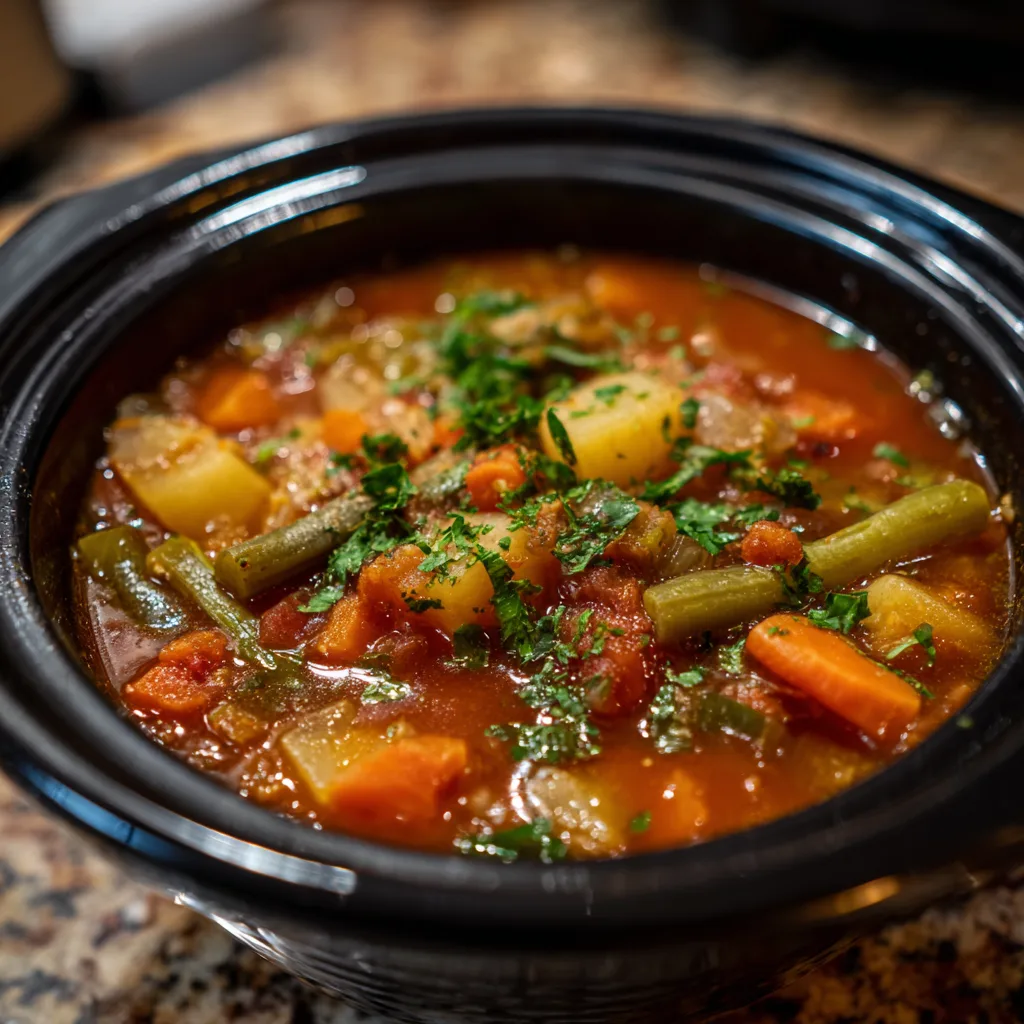What Is Crockpot Vegetable Soup?
Crockpot vegetable soup is a wholesome, comforting dish made by slow-cooking a mix of fresh vegetables in a slow cooker. This method transforms simple ingredients into a rich, flavorful soup with minimal effort. Unlike traditional stovetop soups, the crockpot gently simmers vegetables over several hours, allowing their flavors to blend deeply and naturally. The result is a hearty meal that feels both nourishing and satisfying.
This style of soup has surged in popularity among busy individuals and families. Its convenience stands out: just chop your veggies, add broth and seasonings, then let the slow cooker do the rest. Whether you want a quick weekday dinner or a make-ahead lunch, crockpot vegetable soup fits seamlessly into modern lifestyles. Moreover, it’s easily customizable to suit dietary needs, making it a favorite for vegetarians, vegans, and those seeking low-calorie, nutrient-rich meals.
Many appreciate how the slow cooker brings out the natural sweetness of vegetables like carrots and onions. The extended cooking time tenderizes even the heartiest root vegetables, creating a silky texture without constant stirring or monitoring. This hands-off approach frees you to focus on other tasks while your meal cooks slowly in the background. Given these advantages, crockpot vegetable soup remains a go-to option for those craving a comforting yet effortless dish.
Why Choose a Crockpot for Vegetable Soup?
Slow cooking offers distinct benefits that elevate vegetable soup. First, it enhances flavor by allowing ingredients to meld over time. Unlike boiling on the stove, which can cause flavors to become harsh or watery, crockpot cooking preserves and deepens the taste. This results in a richer, more balanced soup.
Second, crockpots promote hands-off preparation. Once you add your ingredients and set the timer, you can walk away. There’s no need for constant stirring or temperature adjustments. This simplicity saves time and reduces stress, especially on busy days.
Energy efficiency also favors slow cookers. They use less electricity than ovens or stovetops, making them a cost-effective choice for long cooking periods. Additionally, slow cookers retain heat well, minimizing heat loss in your kitchen.
When compared to stovetop cooking, crockpots require less attention but deliver similar or better results in flavor and texture. Pressure cookers cook faster but may sacrifice some depth of flavor due to shorter cooking times. In contrast, crockpot soups develop a complexity and warmth that’s hard to replicate quickly.
Ultimately, choosing a crockpot for vegetable soup combines ease, economy, and enhanced taste, making it an ideal method for preparing this classic comfort food.
Core Vegetables for Crockpot Vegetable Soup
Onions, garlic, carrots, celery, and potatoes form the backbone of any great crockpot vegetable soup. These ingredients provide a solid foundation of flavor and texture. Onions and garlic add aromatic depth, while carrots and celery contribute subtle sweetness and crunch. Potatoes bring heartiness and help thicken the broth as they cook down. Together, they create a balanced base that supports additional vegetables or proteins.
Seasonal variations let you keep this soup fresh and exciting year-round. In spring and summer, consider adding zucchini, green beans, or fresh peas. Fall and winter invite root vegetables like parsnips, turnips, and butternut squash. Feel free to substitute or combine based on availability and taste preferences. This flexibility makes crockpot vegetable soup a versatile dish that adapts to what’s in your pantry.
Broth and Liquids: Building the Soup Base
Vegetable broth usually serves as the liquid foundation in crockpot vegetable soup. Choosing a low-sodium or homemade broth helps you control salt levels and avoid overpowering flavors. Broth enriches the soup with savory notes while allowing vegetable flavors to shine.
For variety, you can swap or mix in other liquids. Tomato juice or crushed tomatoes add a tangy sweetness and deepen color. Some recipes call for plain water, especially if you prefer a lighter broth or plan to intensify flavors with herbs and seasonings. Combining liquids offers further customization, helping you craft a soup that suits your palate perfectly.
Herbs and Seasonings: Enhancing Flavor Depth
Herbs such as thyme, bay leaves, and parsley commonly flavor crockpot vegetable soup. Thyme adds earthiness, bay leaves contribute subtle bitterness, and fresh parsley brightens the final dish. Using a combination of these herbs creates layers of flavor.
Spices also play an important role. Black pepper provides warmth, smoked paprika adds a mild smoky note, and garlic powder boosts the overall savoriness. Remember, seasoning balance matters. Adding salt gradually during cooking lets you adjust taste without overdoing it. Over-seasoning can mask vegetable flavors and reduce the soup’s natural freshness.
Optional Add-ins: Boosting Nutrition and Variety
To increase protein and texture, many cooks include beans, lentils, corn, peas, or zucchini. Beans and lentils contribute plant-based protein and fiber, making the soup more filling. Corn and peas add pops of sweetness and color. Zucchini offers moisture and soft texture that blends well with other vegetables.
Consider dietary preferences when selecting add-ins. Vegan and gluten-free diets easily accommodate these ingredients. Just ensure you choose gluten-free broth and check canned items for additives if you have sensitivities. Optional add-ins let you tailor the soup to your nutritional goals and flavor desires without complicating preparation.
Preparation: Getting Your Vegetables Ready
Start by washing all your vegetables thoroughly to remove any dirt or residues. Peel root vegetables such as carrots and potatoes to ensure a smooth texture. Then, chop everything into uniform pieces. Consistent sizes help the vegetables cook evenly in the crockpot.
While this step is simple, don’t rush it. Taking time to prepare your ingredients carefully makes a noticeable difference in flavor and texture. For extra depth, consider sautéing aromatics like onions and garlic in a small pan with a bit of olive oil before adding them to the crockpot. This optional step caramelizes sugars in the vegetables, boosting the soup’s aroma and richness.
Sautéing can add 5-10 minutes to prep time but delivers a more complex base flavor. If you prefer quicker prep, you can skip this step and rely on slow cooking to meld flavors naturally.
Assembling the Soup: Layering Ingredients for Best Results
When adding ingredients to the crockpot, start by pouring in your broth or liquid base. This ensures the slow cooker heats evenly and the vegetables don’t dry out during cooking.
Next, add your prepared vegetables on top of the liquid. Arrange root vegetables like potatoes and carrots at the bottom since they require more cooking time. Leafy or delicate vegetables can go on top to avoid overcooking.
Sprinkle your herbs and seasonings evenly over the vegetables. Add bay leaves, thyme, pepper, and salt at this stage for optimal infusion during cooking.
Once all ingredients are in the crockpot, gently stir to combine everything. Stirring helps distribute flavors and seasoning uniformly. However, avoid excessive stirring as it can break down vegetables and make the soup mushy.
Cooking Instructions: Timing and Temperature
Set your crockpot to low or high depending on your schedule. Cooking on low typically requires 6 to 8 hours, perfect for preparing the soup overnight or while you’re at work. High heat cooks faster, usually within 3 to 4 hours, which suits last-minute meal prep.
Check the soup around the minimum cooking time to assess vegetable tenderness. Root vegetables should be fork-tender but not falling apart. If needed, continue cooking until the desired texture is reached.
Taste the soup during this stage to adjust seasoning. Slow cooking can mellow spices, so a final salt or pepper boost may be necessary before serving.
Final Touches: Elevating Your Crockpot Vegetable Soup
Before serving, remove any bay leaves or herb stems to avoid unpleasant bites. Taste the soup one last time and adjust seasoning if needed.
For added freshness and presentation, garnish with chopped fresh herbs like parsley or cilantro. A squeeze of lemon juice can brighten flavors and add subtle acidity, balancing the soup’s richness.
If desired, sprinkle grated cheese such as Parmesan on top for a savory finish. This step is optional and depends on dietary preferences.
These small final touches transform a simple crockpot vegetable soup into a flavorful, satisfying meal that feels homemade and special.
Health Benefits of Crockpot Vegetable Soup
Crockpot vegetable soup offers impressive nutritional value while remaining low in calories and fat. Packed with fiber from fresh vegetables and legumes, this soup supports healthy digestion and promotes a feeling of fullness. Fiber also aids in regulating blood sugar and lowering cholesterol levels, which benefits heart health.
The variety of colorful vegetables supplies essential vitamins and minerals, such as vitamin A, vitamin C, potassium, and antioxidants. These nutrients strengthen the immune system and protect against chronic diseases. Because it’s low in calories yet nutrient-dense, crockpot vegetable soup fits well into weight management plans without sacrificing flavor or satisfaction.
Additionally, the slow cooking process helps preserve nutrient content better than some faster cooking methods. Overall, this soup nourishes the body while delivering comfort in every spoonful.
Dietary Variations: Adapting to Your Needs
Crockpot vegetable soup easily suits vegan and vegetarian diets. Adding plant-based protein sources like beans or lentils boosts the nutritional profile and keeps the soup filling. You can also enrich flavor with vegetable broth and umami-rich ingredients that deepen taste without animal products.
For those following gluten-free diets, choose gluten-free broth and thickeners like cornstarch or potato starch. Avoid additives containing gluten to prevent cross-contamination. This simple swap ensures everyone can enjoy the soup safely.
Low-sodium and low-fat versions help those managing heart health or dietary restrictions. Use low-sodium broth, reduce added salt, and skip high-fat garnishes like cheese or cream. Instead, rely on fresh herbs and spices to bring bold flavor without extra sodium or fat. These modifications keep the soup heart-healthy and accessible to many.
Flavor Enhancements: Boosting Taste and Complexity
Enhance your crockpot vegetable soup by adding umami-rich ingredients such as nutritional yeast, miso paste, or a splash of soy sauce. These add depth and savory notes, making the soup more satisfying and layered in flavor.
For heat lovers, sprinkle chili flakes or stir in hot sauce to introduce a gentle kick. Spicy variations can warm the palate and complement the natural sweetness of vegetables.
If you prefer a touch of sweetness, add ingredients like maple syrup or sweet potato. These balance savory flavors and create a harmonious taste experience. Adjust these enhancements to suit your preferences and keep your soup exciting every time you make it.
Common Queries About Crockpot Vegetable Soup
Can I use frozen vegetables?
Absolutely. Frozen vegetables make crockpot vegetable soup even more convenient. They retain most of their nutrients since they are typically frozen shortly after harvest. Using frozen veggies saves prep time without sacrificing flavor or texture. Add them directly to the slow cooker without thawing to avoid sogginess. Just keep in mind that some softer vegetables might cook faster, so adjust cooking time accordingly.
How long can I store leftovers?
You can safely refrigerate leftover soup for up to five days. Store it in an airtight container to maintain freshness. For longer storage, freeze the soup in portions. It keeps well in the freezer for up to three months. When reheating, thaw it overnight in the fridge and warm gently on the stove or in the microwave. Avoid repeated reheating to preserve taste and texture.
Can I add meat to the soup?
Yes, adding meat like ground beef or turkey is possible. If you choose to include meat, brown it separately before adding it to the crockpot. This step ensures proper cooking and develops richer flavor. Cook meat thoroughly before mixing with vegetables to avoid food safety issues. Also, adjust seasoning to balance the added richness and consider cooking time since meat can require more time to tenderize.
How can I thicken the soup?
If your soup feels too thin, try mashing some of the potatoes or softer vegetables directly in the crockpot. This naturally thickens the broth while enhancing texture. Alternatively, use an immersion blender to puree part of the soup for a creamier consistency. Another option is making a slurry by mixing cornstarch with cold water and stirring it into the soup. Cook for an additional 10-15 minutes to allow thickening. Avoid adding too much thickener to prevent a gluey texture.
Can I prepare the soup in advance?
Yes, crockpot vegetable soup is ideal for advance preparation. Simply chop and assemble all ingredients the night before. Store the crockpot insert covered in the refrigerator overnight. In the morning, place the insert into the cooker and start the cooking cycle. This method saves time while preserving fresh flavors. Just ensure you don’t leave raw ingredients at room temperature for too long to maintain food safety.
Crockpot Vegetable Soup Recipe – Easy, Healthy & Hearty Comfort Food

This hearty and nutritious vegetable soup comes together effortlessly in a slow cooker. Packed with seasonal vegetables and fragrant herbs, it offers a comforting and wholesome meal perfect for any day of the week.
Ingredients
- 1 medium onion, diced
- 2 carrots, peeled and sliced
- 2 celery stalks, chopped
- 2 medium potatoes, peeled and diced
- 4 cups vegetable broth
- 2 cloves garlic, minced
- 1 teaspoon dried thyme
- 2 bay leaves
- Salt and pepper to taste
- Optional: 1 cup frozen peas or corn
Instructions
Notes




